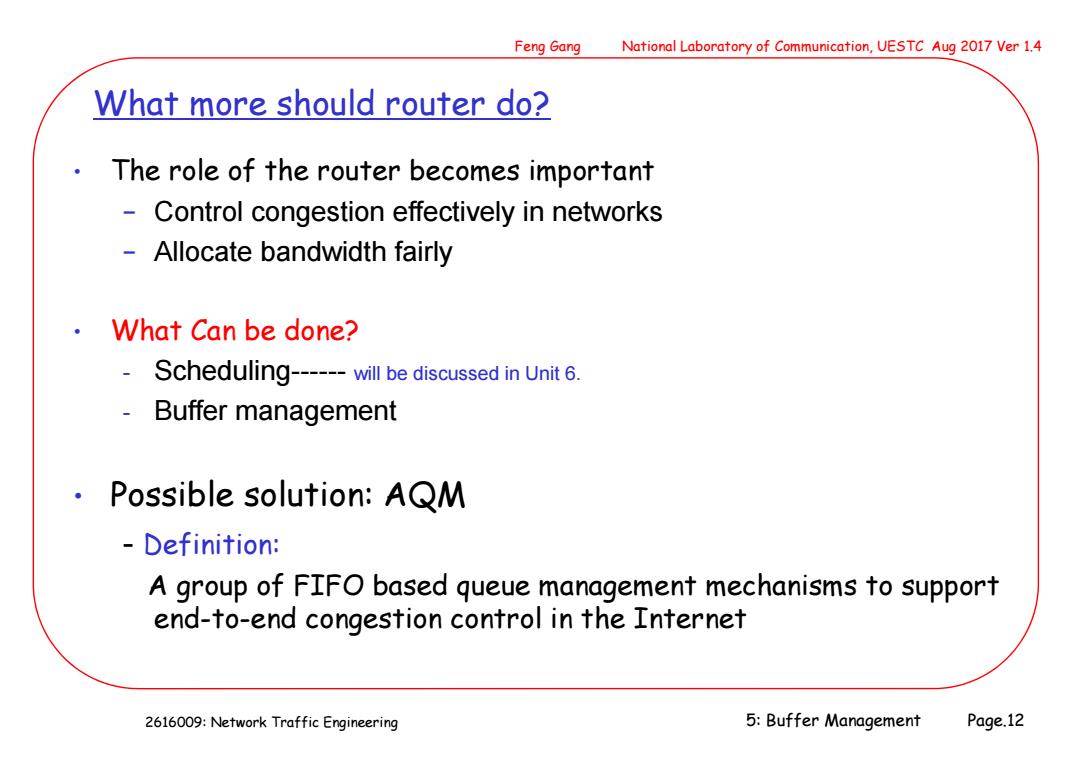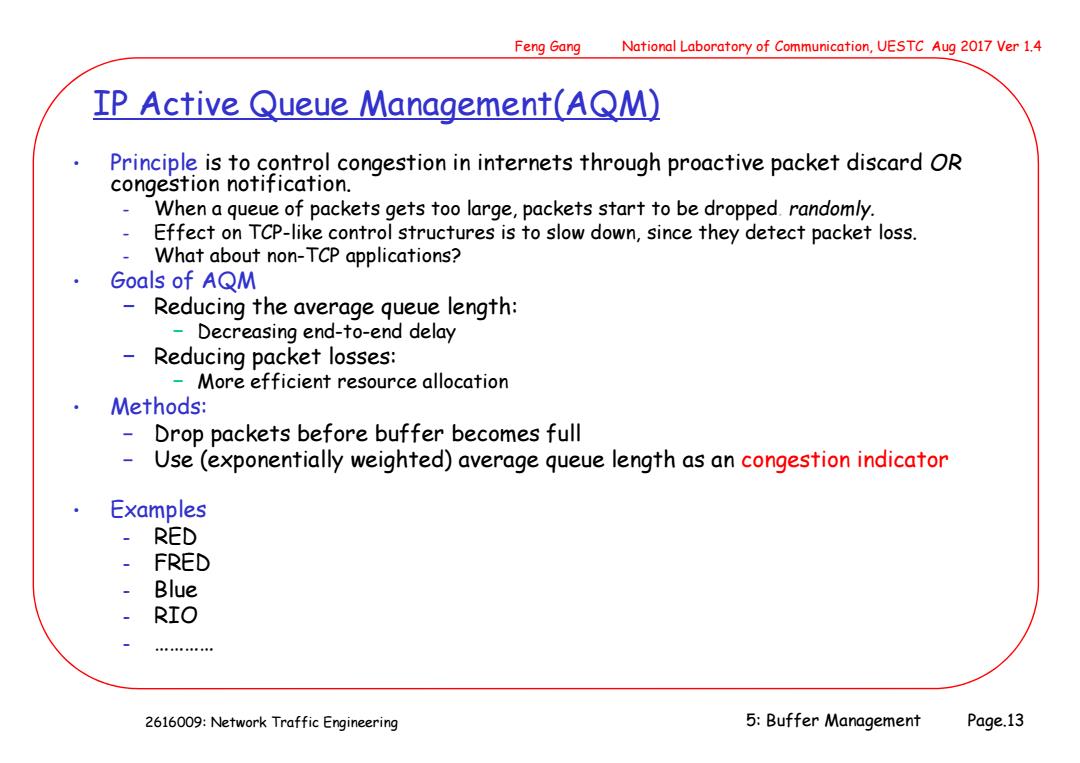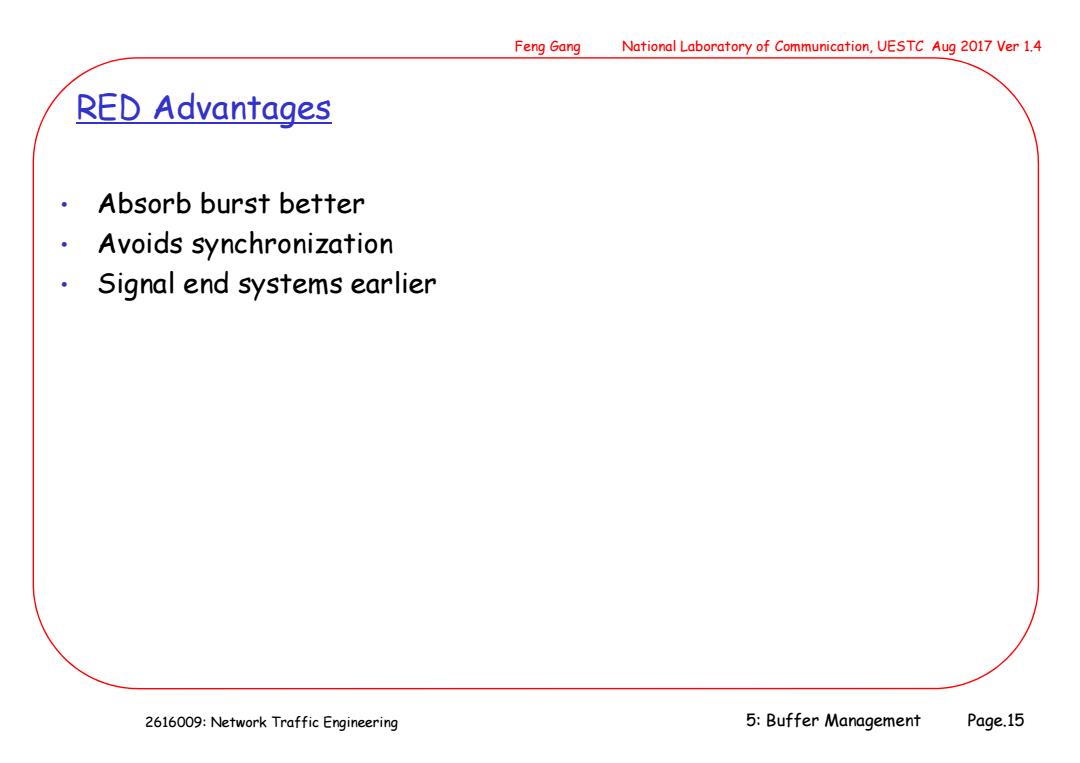
Feng Gang National Laboratory of Communication,UESTC Aug 2017 Ver 1.4 Drawbacks of FIFO with Tail-drop 。 Buffer lock out by misbehaving flows a small number of flows monopolize usage of buffer capacity ·Full-queue The buffer is always full(high queueing delay) Synchronizing effect for multiple TCP flows Performance Degradation in current TCP Congestion Control Burst or multiple consecutive packet drops Bad for TCP fast recovery Low link utilization Congestion collapse 2616009:Network Traffic Engineering 5:Buffer Management Page.11
2616009: Network Traffic Engineering Feng Gang National Laboratory of Communication, UESTC Aug 2017 Ver 1.4 5: Buffer Management Page.11 Drawbacks of FIFO with Tail-drop • Buffer lock out by misbehaving flows - a small number of flows monopolize usage of buffer capacity • Full-queue - The buffer is always full (high queueing delay) • Synchronizing effect for multiple TCP flows • Performance Degradation in current TCP Congestion Control - Burst or multiple consecutive packet drops . Bad for TCP fast recovery - Low link utilization - Congestion collapse

Feng Gang National Laboratory of Communication,UESTC Aug 2017 Ver 1.4 What more should router do? The role of the router becomes important Control congestion effectively in networks Allocate bandwidth fairly What Can be done? Scheduling------will be discussed in Unit 6. Buffer management Possible solution:AQM Definition: A group of FIFO based queue management mechanisms to support end-to-end congestion control in the Internet 2616009:Network Traffic Engineering 5:Buffer Management Page.12
2616009: Network Traffic Engineering Feng Gang National Laboratory of Communication, UESTC Aug 2017 Ver 1.4 5: Buffer Management Page.12 What more should router do? • The role of the router becomes important − Control congestion effectively in networks − Allocate bandwidth fairly • What Can be done? - Scheduling------ will be discussed in Unit 6. - Buffer management • Possible solution: AQM - Definition: A group of FIFO based queue management mechanisms to support end-to-end congestion control in the Internet

Feng Gang National Laboratory of Communication,UESTC Aug 2017 Ver 1.4 IP Active Queue Management(AQM) Principle is to control congestion in internets through proactive packet discard OR congestion notification. When a queue of packets gets too large,packets start to be dropped.randomly. Effect on TCP-like control structures is to slow down,since they detect packet loss. What about non-TCP applications? Goals of AQM Reducing the average queue length: - Decreasing end-to-end delay Reducing packet losses: More efficient resource allocation 。 Methods: Drop packets before buffer becomes full Use(exponentially weighted)average queue length as an congestion indicator Examples RED FRED Blue RIO 2616009:Network Traffic Engineering 5:Buffer Management Page.13
2616009: Network Traffic Engineering Feng Gang National Laboratory of Communication, UESTC Aug 2017 Ver 1.4 5: Buffer Management Page.13 IP Active Queue Management(AQM) • Principle is to control congestion in internets through proactive packet discard OR congestion notification. - When a queue of packets gets too large, packets start to be dropped. randomly. - Effect on TCP-like control structures is to slow down, since they detect packet loss. - What about non-TCP applications? • Goals of AQM − Reducing the average queue length: − Decreasing end-to-end delay − Reducing packet losses: − More efficient resource allocation • Methods: − Drop packets before buffer becomes full − Use (exponentially weighted) average queue length as an congestion indicator • Examples - RED - FRED - Blue - RIO - …………

Feng Gang National Laboratory of Communication,UESTC Aug 2017 Ver 1.4 Random Early Detection (RED) Floyd/Jacobson (1993,ToN) 。 Design goals - Congestion avoidance,as opposed to congestion reaction. Control average delay through a router.Achieved by controlling queue length. Fairness.For instance,don't always select newly arriving packets to drop. Avoid network-wide collapse. 。 Metric is moving average of queue lengths small bursts pass through unharmed only affects sustained overloads Packet drop probability is a function of mean queue length prevents severe reaction to mild overload Can mark packets instead of dropping them allows sources to detect network state without losses 。 No bias against bursty sources Controls queue length regardless of endpoint cooperation 2616009:Network Traffic Engineering 5:Buffer Management Page.14
2616009: Network Traffic Engineering Feng Gang National Laboratory of Communication, UESTC Aug 2017 Ver 1.4 5: Buffer Management Page.14 Random Early Detection (RED) • Floyd/Jacobson (1993, ToN) • Design goals - Congestion avoidance, as opposed to congestion reaction. - Control average delay through a router. Achieved by controlling queue length. - Fairness. For instance, don’t always select newly arriving packets to drop. - Avoid network- wide collapse. • Metric is moving average of queue lengths - small bursts pass through unharmed - only affects sustained overloads • Packet drop probability is a function of mean queue length - prevents severe reaction to mild overload • Can mark packets instead of dropping them - allows sources to detect network state without losses • No bias against bursty sources • Controls queue length regardless of endpoint cooperation

Feng Gang National Laboratory of Communication,UESTC Aug 2017 Ver 1.4 RED Advantages Absorb burst better Avoids synchronization Signal end systems earlier 2616009:Network Traffic Engineering 5:Buffer Management Page.15
2616009: Network Traffic Engineering Feng Gang National Laboratory of Communication, UESTC Aug 2017 Ver 1.4 5: Buffer Management Page.15 • Absorb burst better • Avoids synchronization • Signal end systems earlier RED Advantages